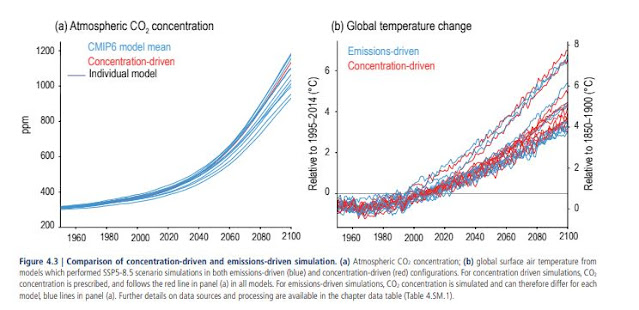Over the past 12 months the Intergovernmental Panel on
Climate Change (IPCC), the UN climate change research office, has in stages released
its Sixth Assessment Report (AR6) on global climate. The report is broken down
into three volumes:
(1) The Physical Science Basis; (2) Vulnerabilities and Impacts; and
(3) Adaptation and Mitigation. A fourth report, the synthesis of
all three volumes, will be complete in late 2022 or early 2023.
Temperature changes between glacial and interglacial periods.
IPCC AR6 global temperature model to 2100.
Thousands of scientists with many different research
specialties—marine biology, ocean physics, glacial science, atmospheric
sciences, to name a very few—collaborate on collating data and writing the
report. Large teams collaborate on each chapter, which are then edited and set
within the larger volume, itself part of the comprehensive Assessment Report.
The six reports have spanned the last thirty-plus years since
the IPCC’s founding in 1988:
1990-92 (AR1);
1995 (AR2); 2001 (AR3); 2007 (AR4); 2015(AR5); 2022 (AR6). The reports have grown in length, scope, and urgency with
each cycle.
IPCC AR6 global CO2 and temperature change models to 2100.
IPCC AR6 global models for temperature, precipitation, September Arctic sea ice extent and mean sea level to 2100.
The latest, AR6, states in the strongest and most
unequivocal terms yet that humans are responsible for the rapid planetary warming
of the past century-plus, and that large changes in the global climate regime
are inevitable without large and immediate reductions in greenhouse gas
emissions.
Since the last glacial maximum
until now, the world has warmed roughly 5°C/9°F. Some temperature rise scenarios
show global increases of that within the next eighty years, with sea level rise
of 0.75 m/2.5 ft, enough to impact coastal cities and homes around the world,
with some
in real danger of being lost.
IPCC AR6 September Arctic sea ice extent model to 2100.
IPCC AR6 ocean surface pH model to 2100.
The combination of these factors and more: higher temperatures,
winters diminishing, shoulder seasons (spring/fall) being compressed into what used
to be winter; greater and more violent precipitation; dramatically warming and
acidifying oceans; loss of ice around the world; in some cases amplify each
other in vulnerable zones such as coasts and low-elevation areas like river
basins. Eustatic (global) sea level rise will also affect river levels and
their local and regional ecosystems. System response to the complicated effects
of global warming will be likewise complex and far-reaching.
Tomorrow: IPCC AR6 Vulnerabilities and Impacts.
Be brave, be steadfast, and be well.











No comments:
Post a Comment